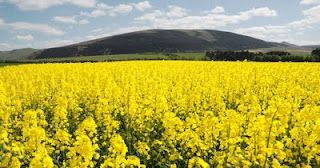I haven't posted anything for a couple of weeks and the reason is long long hours of rock crushing, grinding and volumetric blending - none of which are immediate enough to be photogenic or exciting enough to be written about. Still, due to popular demand (one comment) here is one of my Edinburgh biaxials.
Basically it is a way of testing glazes that gives far more insight than just mixing up an individual glaze. The basic glaze has two variables, one along each axiz, so that a sort of map is made up. The first 4 vertical rows on this tile are a 20 glaze biaxial based on a basalt rock. The two variables are calcium, which is increased from left to right, and silica, which is increased from top to bottom.
4 corner glazes are mixed up to a specific volume and the rest of the glazes are made up by volumetrically blending these glazes using syringes.
It's a long process and as you can see from this tile, rarely gives a final glaze - more an insight into how the materials are behaving. Most of these glazes are rather revolting brown sludges but there is a bit of promise around glaze 14, so this will be the starting point of the next.....Onwards and upwards.....
Welcome
Welcome to my blog. I will attempt to make it much more than just a pitiful list of the relentlessly mundane minutiae of my daily existence but if you feel that I have failed try to imagine all the stuff that I haven't posted.
Monday, 30 May 2011
Sunday, 8 May 2011
It's over......
......no no, settle back....it really is Over. Near Cambridge. The site of one of the largest open quarries in the UK, and also one of the 2 largest sites of mesolithic, neolithic, bronze age and iron age flint tools. In fact, while I was seiving through a large pile of sand I found a mesolithic flint blade that was napped between 6.5 and 10 thousand years ago.
The image shows students working on the site, excavating fire pits etc. In the morning they napped flints and used them to skin rabbits, then had a go at pit firing pots that they had made. It was carnage! It was reassuring to be an onlooker and realise that I do actually know something after all.
I was there to get my hands on some of the Oxford clay, which sits under the gravels, flints and the sand there. I checked out some of the river clays that had been deposited later but here they were far too high in organic matter to be any use.
Back home the ball mill is running at full pelt. I've broken my steel mortar and pestle(!) so there's welding to be done and then it's out with the syringes for biaxials from Scotland......
Wednesday, 4 May 2011
I've got a tan.......guess where I am.
It's a beach and this is bank holiday Monday, so definitely not anywhere in East Anglia.
Clue: it was a scene of violent carboniferous upheaval, where the local sedimentary rocks were ripped and split apart by a giant volcano with numerous plugs, dykes, sills and laccoliths.
Clue 2: James Hutton developed his theory of geology here and there is a section of rock named after him.
Yes indeed....it can only be Edinburgh - but look at the sky! What a total pleasure it was fossicking in this area.
This rounded dome is a microgranite batholith. I'm ashamed to say that after 2 days of climbing and walking I only reached halfway up the side of this.
Now home, with another carload of samples and preparing for another day with the Cambridge archeologists......
Subscribe to:
Comments (Atom)



